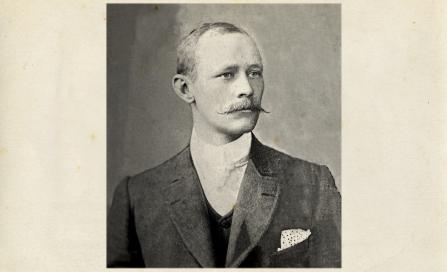|
|
Edward Jeaffreson JacksonEdward ‘Jeaff’ Jackson was born in the middle-class London suburb of Islington in 1862.There was then already strong interest in the revival of vernacular English design and craftsmanship from the medieval period and earlier. AWN Pugin and John Ruskin were strong advocates of Gothic design. William Morris was beginning the career that would see him become the ‘prophet’ of the Arts and Crafts movement which expressed an utopian hope that beauty might be infused into the lives of the working class and the hardships of life ameliorated in the process. As a trainee architect and student between 1879 and 1884, Jackson was influenced by the work of the architect Richard Norman Shaw whose revival designs evoked the architecture of earlier centuries – the so-called ‘Queen Anne style’. Newly married, Jackson left for Australia in 1884 before completing his studies. He thereby joined other significant British emigré architects such as Walter Liberty Vernon, Howard Joseland and John Sulman who brought English styles to Sydney as the city’s middle class suburbs were expanding and providing a canvas for their designs. Jackson moved to North Sydney (then St Leonards) shortly after and joined the Colonial Architect’s Department where he worked on a Gothic design for the Medical School at Sydney University. The Jacksons had two daughters in North Sydney and Jeaff became the church warden of the local Anglican Church, St Thomas’. He designed the small vicarage for the rector there – a building which still stands near the church. In 1895/96 he designed a house called 'Hanney' (now demolished) in Alfred Street, that would become his family home by 1900. Jackson visited Britain with his family in July 1900 and returned to Australia in February 1901. During this time he almost certainly familiarised himself with contemporary Arts and Crafts architecture, and the work of CFA Voysey in particular. 'Kelrose', designed for Dr Capper around 1902 in Miller Street North Sydney, is evidence of the immediate influence of Voysey's work. Jackson’s local influence is most apparent in the work of BJ Waterhouse who designed several large Arts and Crafts style homes on the harbour foreshore in the early 1900s. But his ideas also helped develop the house types commonly known as ‘Federation-style’. Jackson’s ‘Tregoyd’, built in 1900 in Mosman, is an important early example of this style. He pioneered the use of the red terracotta roof tiles that came to characterise Sydney's Federation-era architecture. But before Jackson returned to England in 1908, ‘with much heart-hurt’, he regretted the spread of what he called ‘scarlet fever’ across Sydney’s suburbs. Then Jackson did not think a national style had yet developed but ‘had nothing but praise’ for his Australian peers. |
|




